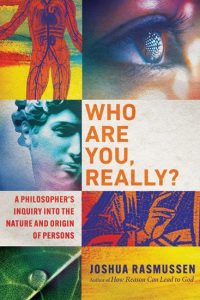
By Joshua Rasmussen.
IVP Academic, 2023.
Paperback, 300 pages, $30.
Reviewed by David Weinberger.
“By my analysis, then, I am led to this vision of reality: the primary nature of reality is not dead, mindless stuff, but is alive and personal.” These are concluding remarks of philosopher Dr. Joshua Rasmussen, whose fascinating and accessible new book “Who Are You, Really?” explores the nature and origin of human persons.
Armed with reason and introspection, Rasmussen brings the reader deep into the trenches of consciousness. Once there, he helps us observe things like thoughts, feelings, intentions, value, and will. What might they tell us about the nature of who we are? To answer that, Rasmussen catalogs various answers provided by both the “materialist” camp (those who believe we are composed merely of matter) and the “dualist” camp (those who maintain we are composed of two distinct substances, one material and one immaterial). Drawing insights from both camps as well as from the latest findings of neuroscience, he deduces we are neither mere bundles of matter nor simply immaterial minds residing in material bodies. Rather, we are fundamentally “conscious substances,” which he describes as beings with the capacity for mental awareness. In other words, we are beings with powers of mind to not only have feelings, but to form thoughts and intentions too. Moreover, Rasmussen notes, everybody can see this by testing it themselves through inner reflection.
For example, many materialists believe that things like thoughts and feelings are nothing more than brain states. But this cannot be right, since there is a difference between first-person experience and third-person observation of an experience. In other words, what it feels like to experience pain is different from a scientific description of what happens in the brain when one experiences something painful. To see this for oneself, Rasmussen encourages the reader to “focus on a sensation within your own consciousness. Then focus on a swirl of sand…You can see directly that the swirl shape is not a sensation, just as you can see directly that an itch in your leg is not a thought in your mind.” Simply put, with our own inner light we can see that things like spatial position, size, and shape are categorically different from things like thoughts, intentions, and feelings.
That is why the “conscious substance” view Rasmussen describes is so attractive. Not only does it have a number of advantages compared to the materialist view, but it also has advantages over the dualist one. For example, if we are substances with mental capacities, not only is there a clean explanation of how we can produce thoughts, intentions, and meanings (as mindedness is simply fundamental to our nature as “conscious substances”), thus precluding a problem that materialism faces, namely how to get mind out of matter, but it also avoids the so-called “mind-body” problem that plagues dualism. Famously, that problem concerns how material states can interact with mental states. How, after all, does a mind state link to a body state? On the conscious substance view, however, there is a single substance that grounds the powers of both mind and body, thus explaining both. Writes Rasmussen:
Instead of supposing that mental states and bodily states can, all on their own, make each other, there is another source of unity–a substance. A substance can unite mental and bodily states by being the subject of them both.
Although space constraints do not permit further treatment here, the book describes other distinct advantages of this position too.
Nevertheless, once we have a grasp of who we are fundamentally as human beings, the second part of the book examines what our identity tells us about ultimate reality. This is because of what Rasmussen terms the “construction problem.” That is, unless the right materials are available for making human beings, the making or “emergence” of human persons is not possible. But since we do in fact exist, those materials must therefore exist. Additionally, just as the discovery of the nature of the human person unveiled the fundamentality of mind, Rasmussen uses similar observation and analysis to conclude that mind must reach deeper than that, in fact to the very foundations of ultimate reality itself. This is because, as we saw above, if the dimensive aspects of matter (shape, size, location) are the wrong materials to construct a thought or feeling, even more so are they the wrong materials to construct a mind. Thus, through careful analysis Rasmussen is led to conclude that, contrary to the popular framing of fundamental reality as mindless, the foundation of reality must in fact be mental.
If this is so, a startling conclusion follows. Mentality, after all, entails reason and will, which are fundamental aspects of personal being. This means that the source of reality itself must be personal in some way. As Rasmussen puts it: “A big thesis, then, that emerges from my inquiry is this: reality is deeply personal. Indeed, if my analysis is right, personal reality seeps to the foundation of all reality. In other words, reality is fundamentally personal.”
Of course, these are weighty matters that demand careful treatment. Rassmussen, whose conciliatory tone and meticulous considerations pour forth on every page of the book, does an exceptional job in this regard. Even for those who disagree with him, there can be no doubt about his commitment to following the truth wherever it leads. And that is a profit to any reader.
David Weinberger is a freelance writer and book reviewer on topics related to philosophy, culture, history, and economics. Follow him on Twitter @DWeinberger03.
Support the University Bookman
The Bookman is provided free of charge and without ads to all readers. Would you please consider supporting the work of the Bookman with a gift of $5? Contributions of any amount are needed and appreciated!